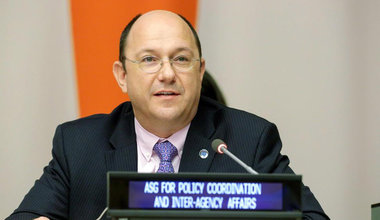In 10 countries with highest out-of-school rates, 40 per cent of children not accessing basic education – UN
 As millions of children around the world prepare to return to school this month, the United Nations Children’s Fund (UNICEF) today highlighted that in the top ten countries with the highest rates of children missing out on primary education, nearly two in every five children – 18 million – are out of school.
As millions of children around the world prepare to return to school this month, the United Nations Children’s Fund (UNICEF) today highlighted that in the top ten countries with the highest rates of children missing out on primary education, nearly two in every five children – 18 million – are out of school.
“For countries affected by conflict, school equips children with the knowledge and skills they need to rebuild their communities once the crisis is over, and in the short-term it provides them with the stability and structure required to cope with trauma,” UNICEF’s Chief of Education, Jo Bourne, said in a news release.
“Schools can also protect children from the trauma and physical dangers around them,” she added. “When children are not in school, they are at an increased danger of abuse, exploitation and recruitment into armed groups.”
The data analysis highlights the extent of an education crisis affecting countries already blighted by conflict, prolonged periods of drought, flash floods, earthquakes and high rates of extreme poverty.
Of the ten countries, UNICEF noted that Liberia is home to the highest proportion of out-of-school children with nearly two-thirds of primary-aged children not accessing school. The second highest is South Sudan, where 59 per cent of children are missing out on their right to a primary education and one in three schools is closed due to conflict.
Afghanistan (46 per cent), Sudan (45 per cent), Niger (38 per cent) and Nigeria (34 per cent) also feature in the top ten, which, according to UNICEF, paints a clear picture of how humanitarian emergencies and protracted crises are forcing children out of school.
Though not one of the top ten countries with the highest rates of out-of-school children, Syria is home to 2.1 million school-age children – between the ages of five and 17 – who are not in school. An additional 600,000 Syrian children living as refugees in the surrounding region are also out of school. The agency also flagged that recent, reliable data from countries including Somalia and Libya are not available either from administrative or survey sources partly due to the continuing conflicts.
“UNICEF fears that without education, a generation of children living in countries affected by conflict, natural disasters and extreme poverty will grow up without the skills they need to contribute to their countries and economies, exacerbating the already desperate situation for millions of children and their families,” the UN agency stated in the news release.
Education continues to be one of the least funded sectors in humanitarian appeals, according to UNICEF. In 2015, humanitarian agencies received only 31 per cent of their education funding needs, down from 66 per cent a decade ago. Despite a 126 per cent increase in education requirements since 2005, funding increased by just four per cent. Moreover, the agency added, education systems equipped to cope with protracted crises cannot be built on the foundations of short-term – and unpredictable – appeals.
 联合国
联合国








